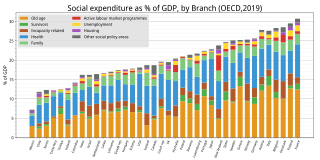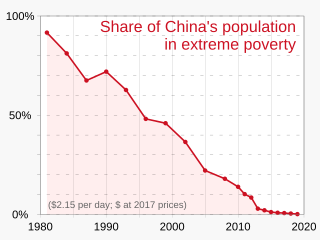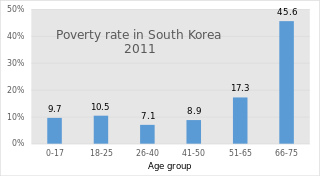
A pension is a fund into which amounts are paid regularly during an individual's working career, and from which periodic payments are made to support the person's retirement from work. A pension may be:

The welfare state of the United Kingdom began to evolve in the 1900s and early 1910s, and comprises expenditures by the government of the United Kingdom of Great Britain and Northern Ireland intended to improve health, education, employment and social security. The British system has been classified as a liberal welfare state system.

A welfare state is a form of government in which the state protects and promotes the economic and social well-being of its citizens, based upon the principles of equal opportunity, equitable distribution of wealth, and public responsibility for citizens unable to avail themselves of the minimal provisions for a good life.

Welfare, or commonly social welfare, is a type of government support intended to ensure that members of a society can meet basic human needs such as food and shelter. Social security may either be synonymous with welfare, or refer specifically to social insurance programs which provide support only to those who have previously contributed, as opposed to social assistance programs which provide support on the basis of need alone. The International Labour Organization defines social security as covering support for those in old age, support for the maintenance of children, medical treatment, parental and sick leave, unemployment and disability benefits, and support for sufferers of occupational injury.
Welfare reform is the process of proposing and adopting changes to a welfare system in order to improve the efficiency and administration of government assistance programs with the goal of enhancing equity and fairness for both welfare recipients and taxpayers. Reform programs have various aims: empowering individuals to help them become self-sufficient, ensuring the sustainability and solvency of various welfare programs, and/or promoting equitable distribution of resources. Welfare reform is constantly debated because of the varying opinions on a government's need to balance the imperatives of guaranteeing welfare benefits and promoting self-sufficiency.

Payroll taxes are taxes imposed on employers or employees, and are usually calculated as a percentage of the salaries that employers pay their employees. By law, some payroll taxes are the responsibility of the employee and others fall on the employer, but almost all economists agree that the true economic incidence of a payroll tax is unaffected by this distinction, and falls largely or entirely on workers in the form of lower wages. Because payroll taxes fall exclusively on wages and not on returns to financial or physical investments, payroll taxes may contribute to underinvestment in human capital, such as higher education.
Hukou is a system of household registration used in mainland China. The system itself is more properly called "huji", and has origins in ancient China; hukou is the registration of an individual in the system. A household registration record officially identifies a person as a permanent resident of an area and includes identifying information such as name, parents, spouse and date of birth. A hukou can also refer to a family register in many contexts since the household register is issued per family, and usually includes the births, deaths, marriages, divorces, and moves, of all members in the family.
Social welfare, assistance for the ill or otherwise disabled and the old, has long been provided in Japan by both the government and private companies. Beginning in the 1920s, the Japanese government enacted a series of welfare programs, based mainly on European models, to provide medical care and financial support. During the post-war period, a comprehensive system of social security was gradually established. Universal health insurance and a pension system were established in 1960.
Many both in and outside Japan share an image of the Japanese work environment that is based on a "simultaneous recruiting of new graduates" and "lifetime-employment" model used by large companies as well as a reputation of long work-hours and strong devotion to one's company. This environment is said to reflect economic conditions beginning in the 1920s, when major corporations competing in the international marketplace began to accrue the same prestige that had traditionally been ascribed to the daimyō–retainer relationship of feudal Japan or government service in the Meiji Restoration.
Social welfare in Sweden is made up of several organizations and systems dealing with welfare. It is mostly funded by taxes, and executed by the public sector on all levels of government as well as private organizations. It can be separated into three parts falling under three different ministries. Social welfare is the responsibility of the Ministry of Health and Social Affairs. Education is the responsibility of the Ministry of Education and Research. The labour market is the responsibility of the Ministry of Employment.
The healthcare reform in China refers to the previous and ongoing healthcare system transition in modern China. China's government, specifically the National Health and Family Planning Commission, plays a leading role in these reforms. Reforms focus on establishing public medical insurance systems and enhancing public healthcare providers, the main component in China's healthcare system. In urban and rural areas, three government medical insurance systems—Urban Residents Basic Medical Insurance, Urban Employee Basic Medical Insurance, and the New Rural Co-operative Medical Scheme—cover almost everyone. Various public healthcare facilities, including county or city hospitals, community health centers, and township health centers, were founded to serve diverse needs. Current and future reforms are outlined in Healthy China 2030.

The Italian welfare state is based partly upon the corporatist-conservative model and partly upon the universal welfare model.

Urbanization in China increased in speed following the initiation of the reform and opening policy. By the end of 2023, China had an urbanization rate of 66.2% and is expected to reach 75-80% by 2035.
Internal migration in the People's Republic of China is one of the most extensive in the world according to the International Labour Organization. This is because migrants in China are commonly members of a floating population, which refers primarily to migrants in China without local household registration status through the Chinese Hukou system. In general, rural-urban migrant most excluded from local educational resources, citywide social welfare programs and many jobs because of their lack of hukou status. Migrant workers are not necessarily rural workers; they can simply be people living in urban areas with rural household registration.

In China today, poverty refers mainly to the rural poor. Decades of economic development has reduced urban extreme poverty. According to the World Bank, more than 850 million Chinese people have been lifted out of extreme poverty; China's poverty rate fell from 88 percent in 1981 to 0.7 percent in 2015, as measured by the percentage of people living on the equivalent of US$1.90 or less per day in 2011 purchasing price parity terms, which still stands in 2022.
Welfare in France includes all systems whose purpose is to protect people against the financial consequences of social risks.

The United States spends approximately $2.3 trillion on federal and state social programs including cash assistance, health insurance, food assistance, housing subsidies, energy and utilities subsidies, and education and childcare assistance. Similar benefits are sometimes provided by the private sector either through policy mandates or on a voluntary basis. Employer-sponsored health insurance is an example of this.

As the economy of China has rapidly developed, issues of labor relations have evolved. Prior to this reform, Chinese citizens were only allowed to work where they originated from. Since 1978, when China began labor force reforms, the overwhelming majority of the labor force were either working at State owned enterprises or as farm workers in the rural countryside. However, over time China began to reform and by the late 90's many had moved from the countryside into the cities in hopes of higher paying jobs and more opportunities. The only connection between the countryside and the city soon became that there was a huge floating population connecting them. Independent unions are illegal in China with only the All-China Federation of Trade Unions (ACTFU) permitted to operate. China has been the largest exporter of goods in the world since 2009. Not only that, in 2013 China became the largest trading nation in the world. As China moved away from their planned economy and more towards a market economy the government has brought on many reforms. The aim of this shift in economies was to match the international standards set by the World Trade Organization and other economic entities. The ACTFU that was established to protect the interests of national and local trade unions failed to represent the workers, leading to the 2010 crackdowns. However, these strikes were centered around foreign companies.

Social security or welfare in Finland is very comprehensive compared to what almost all other countries provide. In the late 1980s, Finland had one of the world's most advanced welfare systems, which guaranteed decent living conditions to all Finns. Created almost entirely during the first three decades after World War II, the social security system was an outgrowth of the traditional Nordic belief that the state is not inherently hostile to the well-being of its citizens and can intervene benevolently on their behalf. According to some social historians, the basis of this belief was a relatively benign history that had allowed the gradual emergence of a free and independent peasantry in the Nordic countries and had curtailed the dominance of the nobility and the subsequent formation of a powerful right wing. Finland's history was harsher than the histories of the other Nordic countries but didn't prevent the country from following their path of social development.

South Korea's pension scheme was introduced relatively recently, compared to other democratic nations. Half of the country's population aged 65 and over lives in relative poverty, or nearly four times the 13% average for member countries of the Organisation for Economic Co-operation and Development (OECD). This makes old age poverty an urgent social problem. Public social spending by general government is half the OECD average, and is the lowest as a percentage of GDP among OECD member countries.











